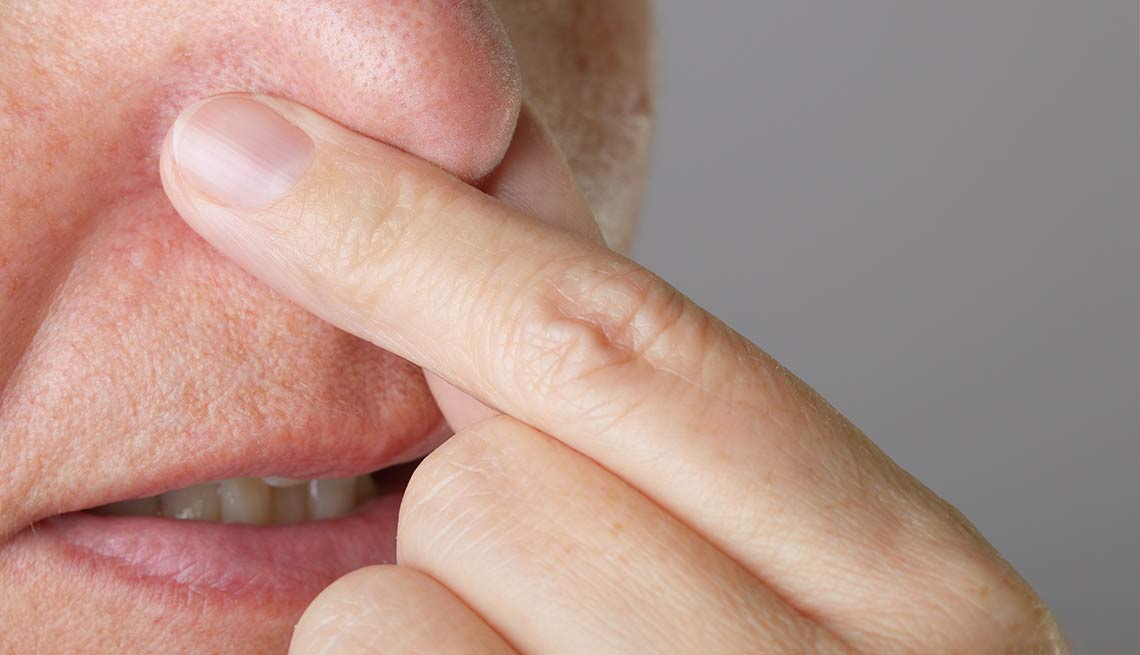
Age-related health conditions and prevention
- Select a language for the TTS:
- UK English Female
- UK English Male
- US English Female
- US English Male
- Australian Female
- Australian Male
- Language selected: (auto detect) - EN
Play all audios:

"The fungus feeds on the nail material, and then it leaves behind a damaged nail," says David Tran, an assistant professor at the California School of Podiatric Medicine at Samuel
Merritt University. Age is the biggest risk factor, according to a paper published in _PLOS Pathogens._ People with diabetes and conditions that limit circulation are also susceptible. THE
FIX Nail it early. Early treatment with a prescription topical solution such as Jublia or Kerydin is best. A more severe infection may need oral meds that require liver checks for harmful
side effects, Tran says. Another option: Laser treatments are more effective than topical treatments, working in 80 percent of cases, one study shows. ACT NOW IF ... ... your nails change
markedly. Discoloration can be the result of skin cancer, which is often diagnosed late when it occurs under nails. WHO MOVED THE BATHROOM? Certain foods can cause fecal incontinence. Tim
Mitchell/Corbis If you've ever lost control of your bowels before you could make it to the toilet, don't freak out — you have plenty of company. A recent peer-reviewed study
reports that fecal incontinence — or accidental bowel leakage (ABL), as it's also known — affects more than 16 percent of those of us over 70. "As we get older, our nerves and
muscles degenerate," says Satish S.C. Rao, M.D., director of the Digestive Health Center at Georgia Regents University. The larger issue is that nearly 30 percent of people with ABL
don't tell their doctors about it, which keeps them from finding a solution. THE FIX Do the clench. The same squeezing exercises that help with urinary problems can also strengthen your
anal sphincter, giving you extra time to get where you're going. Get a breath test. It could be what you're eating. Certain foods can cause you to go before you're ready. Ask
a gastroenterologist for a breath test to see if you don't properly metabolize foods that include the fruit sugar fructose, the milk sugar lactose, and fructan, a string of molecules
in foods such as wheat products, onions, garlic and artichokes, recommends Rao. Stretch it out. Your rectum is usually a "compliant reservoir," Rao says. In some people, however,
the rectum stiffens into a rigid tube that can't accommodate pileups. In this case, your doctor may use a balloon to stretch your rectum, or recommend surgery, Rao adds. ACT NOW IF ...
... you have chronic diarrhea, blood or pus in your stool, a fever, diarrhea at night, dehydration or unexpected weight loss, suggests the Merck Manual. WHERE DID THESE SPOTS COME FROM? Most
dark spots caused by the sun are not dangerous, but a dermatologist can help you stay on top of changing patterns that can signal problems, says Jane Grant-Kels, M.D., director of
dermatopathology at the University of Connecticut. THE FIX Zap 'em. Brown spots are often harmless solar lentigines, also known as age spots. About 14 percent of middle-aged people have
them, notes a study in the journal _PLOS One._ These crop up more as you age, in places that see the most UV rays, such as your face, hands and forearms. Use a skin-lightening cream, or a
dermatologist can zap the spots with liquid nitrogen or a laser. Freeze them off! Seborrheic keratoses are genetic wartlike growths that are anywhere from yellow to brown to black in color.
Although they are harmless, "they can sometimes be quite scary looking," Grant-Kels says. She encourages most patients to leave the spots alone, but a dermatologist can freeze them
for you. Laser away. Red bumps are often cherry angiomas — clusters of dilated blood vessels. They're benign, but if you hate how they look, a doctor can erase them with a laser or
shave them off with a scalpel. ACT NOW IF ... ... any skin spot concerns you. Skin cancer is the most common cancer in the United States, according to the Centers for Disease Control and
Prevention. Symptoms for basal and squamous cell cancers include an unusual growth that doesn't heal. Signs of melanoma include a new spot, or one that changes size, shape or color.
Your dermatologist can help track dangerous changes. WHY ARE MY FEET SO ... FRAGRANT? The bottoms of your feet are teeming with Staphylococcus bacteria, little organisms that break down the
substance leucine in sweat to produce isovaleric acid. That's the compound that makes feet stink, according to research from the U.K. What's more, your sweat encourages those
bacteria to multiply. Foot odor may be the result of a foot fungus. Getty Images Older people, who tend to be less flexible, often skip a thorough foot scrubbing in the shower, making it
more likely that the bacteria fester. THE FIX Set your dogs free. Air out your feet by wearing sandals after work or your workout. Letting your feet dry out can help fight the bacteria. Brew
tea for two. If that's not enough, an astringent foot soak can keep the bacteria at bay, podiatrist Tran suggests. Brew a strong pot of black tea, allow it to cool, and soak your feet
in it for 10 minutes a day for a week or so. Another option is to try Domeboro crystals. When the crystals mix with water, they release aluminum acetate, which helps zap sweat and odor.
